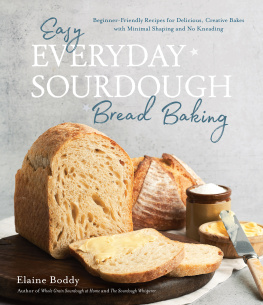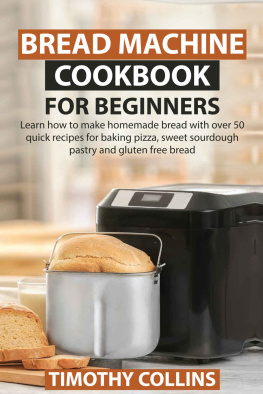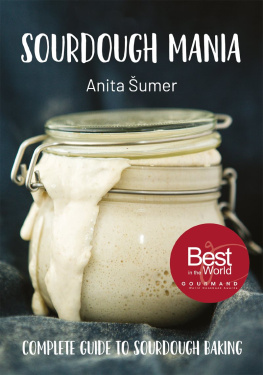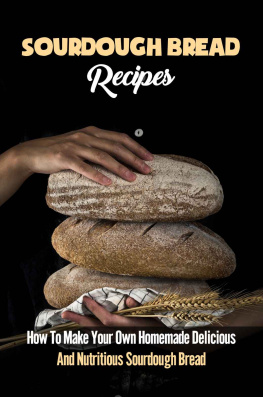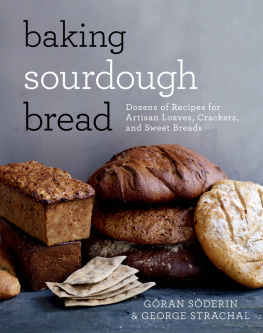Contents
Guide
Beginner-Friendly Recipes for Delicious, Creative Bakes with Minimal Shaping and No Kneading
Easy
EVERYDAY
SOURDOUGH
*Bread Baking
Elaine Boddy
Author of Whole Grain Sourdough at Home and The Sourdough Whisperer

The author and publisher have provided this e-book to you for your personal use only. You may not make this e-book publicly available in any way. Copyright infringement is against the law. If you believe the copy of this e-book you are reading infringes on the authors copyright, please notify the publisher at: http://us.macmillanusa.com/piracy.
I dedicate this book to everyone who has ever baked one of my recipes xx
Hello lovely bakers!
Welcome to my sourdough world. This book brings together so many things that I love: making sourdough as simply as possible; using a sourdough starter in as many ways as possible; and utilizing equipment and ingredients that can be readily found in most kitchens. Let me explain .
Sourdough is truly a simple beast that has been made to look complicated. I am here to undo all of that and promise you that it is far simpler to make than you may think. I ensure that my recipes are uncomplicated, without unnecessary jargon or steps, and are accessible to everyone who would like to make wonderful, tasty, homemade bread of their own.
The recipes in this book are therefore designed so that sourdough bakers of all levels can make them, whether you are a beginner or have had more experience with making sourdough. The book, although not a beginners guide to making sourdough, includes as much detail as possible in the recipes to ensure that if you are brand-new to sourdough, they will not be daunting.
The methods all utilize my simple, straightforward ways of making sourdough, from easy first mixes to building up the dough by performing pulls and folds on it (see the next section for more details). In addition, many use my typical overnight proof to fully develop the dough.
I have listened to hundreds of home bakers around the world and taken on board the elements of sourdough baking that they enjoy and tried to help with the parts of the process they struggle with the most. In this book, you will find an entirely new collection of recipes that have been specifically designed for ease and workable timings. They all use the tins, pans and baking sheets we already have in our kitchens in new and creative ways. This gives us a chance to get more uses out of the items we already own, while providing the added benefit of giving the doughs built-in shaping support and removing the difficulties many bakers have when it comes to shaping doughs.
The recipes also utilize flours and ingredients that are typical in home kitchens, or are easily accessible, and show how sourdough breads can be made in different shapes and forms, as well as be bursting with a variety of flavors and textures.
I hope you enjoy my recipes, and for more ideas, hints and tips, check out my previous books, Whole Grain Sourdough at Home and The Sourdough Whisperer.
Happy baking!
These are my top tips and helpful hints to ensure you have success with the recipes in this book. From all the questions I have ever been asked and the guidance and assistance I have given sourdough bakers all over the world, these are the pointers that are the absolute keys to being a happy sourdough baker.
The recipes in this book are simple and great for beginner sourdough bakers. However, if you do not have a starter or have never baked a loaf of sourdough before, I recommend you visit my blog where you can find detailed step-by-step instructions and photographs to build a starter and to bake your first loaf: foodbodsourdough.com. You can also get one or both of my previous books that share my master recipe and many other tips and tricks for beginners.
Look After Your Starter
Our sourdough starters are pivotal in our sourdough success. If they do not perform well, our doughs, and therefore our bakes, will not work well, so it is important to keep your starter healthy and strong. Get to know your starter, take note of how it looks and smells and behaves when it is working well so that you will know if anything changes. And if anything does change, take action accordingly.
A healthy active white flour starter has a consistency like thick pancake batter. It grows and doubles several hours after feeding it with flour and water, and may have a bubbly surface and bubbles throughout.
A healthy, active whole-grain starter will be textured and aromatic. It will be thicker than a white starter, and will not break out in a bubbly surface. It will grow in the same way and be full of texture throughout the mix.
Time and temperature are key factors when making sourdough, and I have added tips in the coming sections regarding how they affect dough, but it is also relevant to our starters, too. When it is cold, starters will take longer to respond and become active after feeding. In this instance, allow your starter more time, or place it somewhere warm for a short while. If you put it in a warm place or it is warm in your kitchen (such as during the summer), please keep a close eye on it. Heat will make starters respond faster, and as a result they can easily work too fast and become thin. When a starter becomes thin, or a white flour starter has teeny tiny bubbles all over the surface, it has also become weak. If this happens, feed it more flour than water and bring it back to its thicker consistency to build the body in your starter again and make it stronger. Repeat this as often as you need to to keep your starter strong. But the key here is to keep in mind how temperature can affect a starters behavior; you can learn a lot just by observing the starters behavior over time.
Keep your starter in a glass container with a fitted lid to prevent contamination. I use Weck 744 jars for my starter. These jars hold a maximum of 580 ml (20 ounces), which is also a perfect size; it can be tempting to keep a lot of starter but an ideal base amount is 50 to 100 grams ( to cup) to keep your starter fit and healthy. By using this size jar, it prevents the temptation to keep unnecessary starter.
In between uses, store your starter in the fridge; this will effectively put your starter to sleep and protect it until you want to use it again. And when you do, take it from the fridge, feed it and use it once it has responded and grown. It is not necessary to feed your starter in between uses, only when you want to use it to make dough.
Choose Good Flour
To ensure a healthy starter, I always recommend feeding it with good-quality flour. If your starter is a white flour starter, feed it with strong white bread flour for best results. A strong flour has a higher level of gluten protein than other flours, such as all-purpose/plain flour, making it perfect for your starter.

